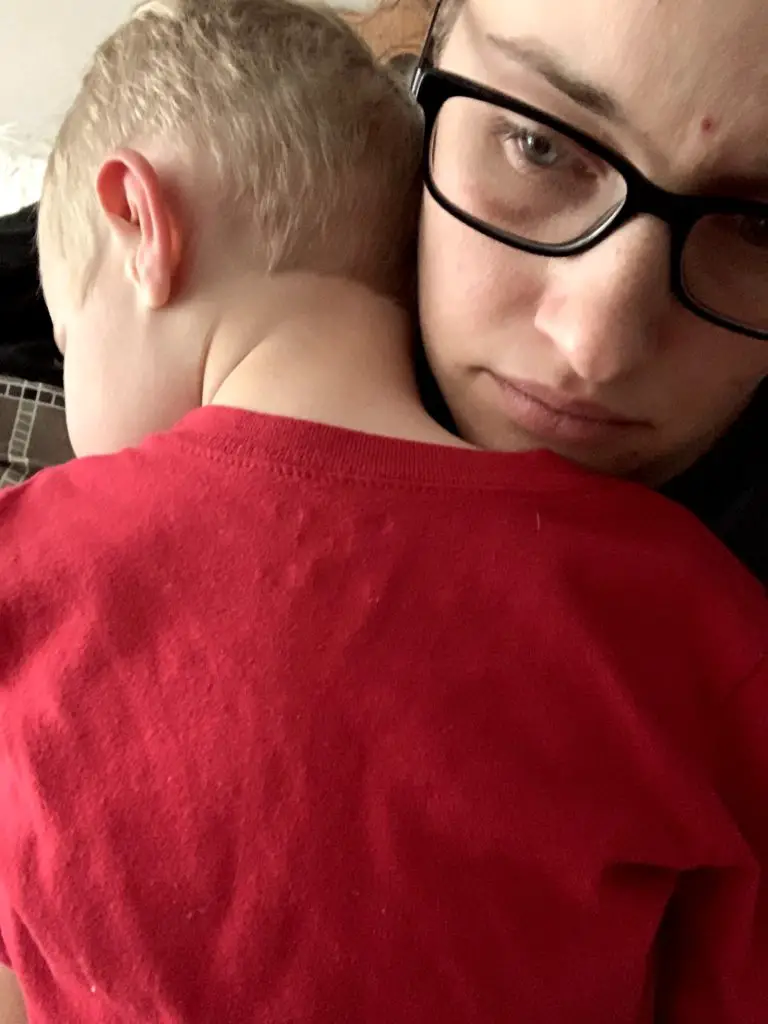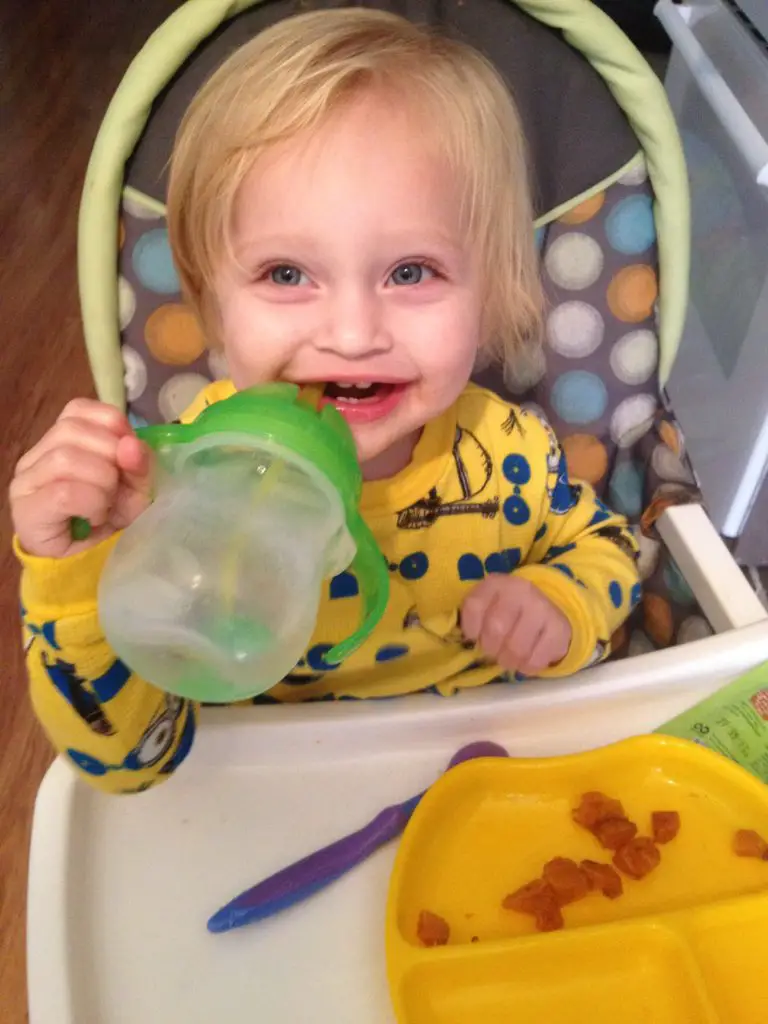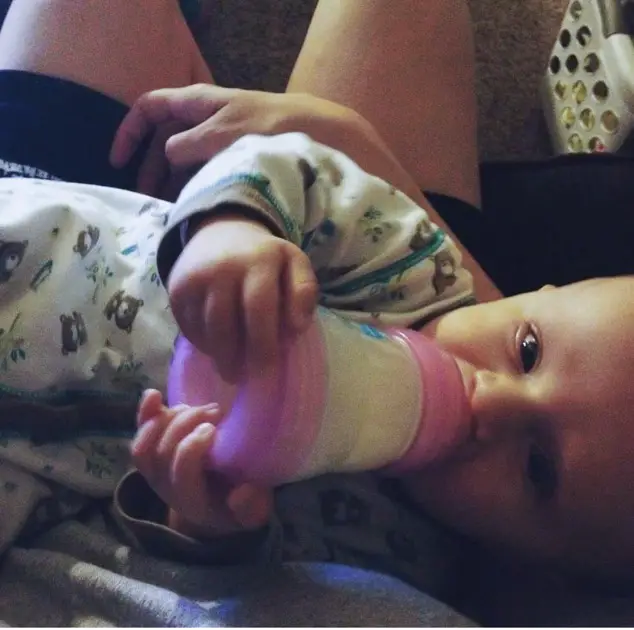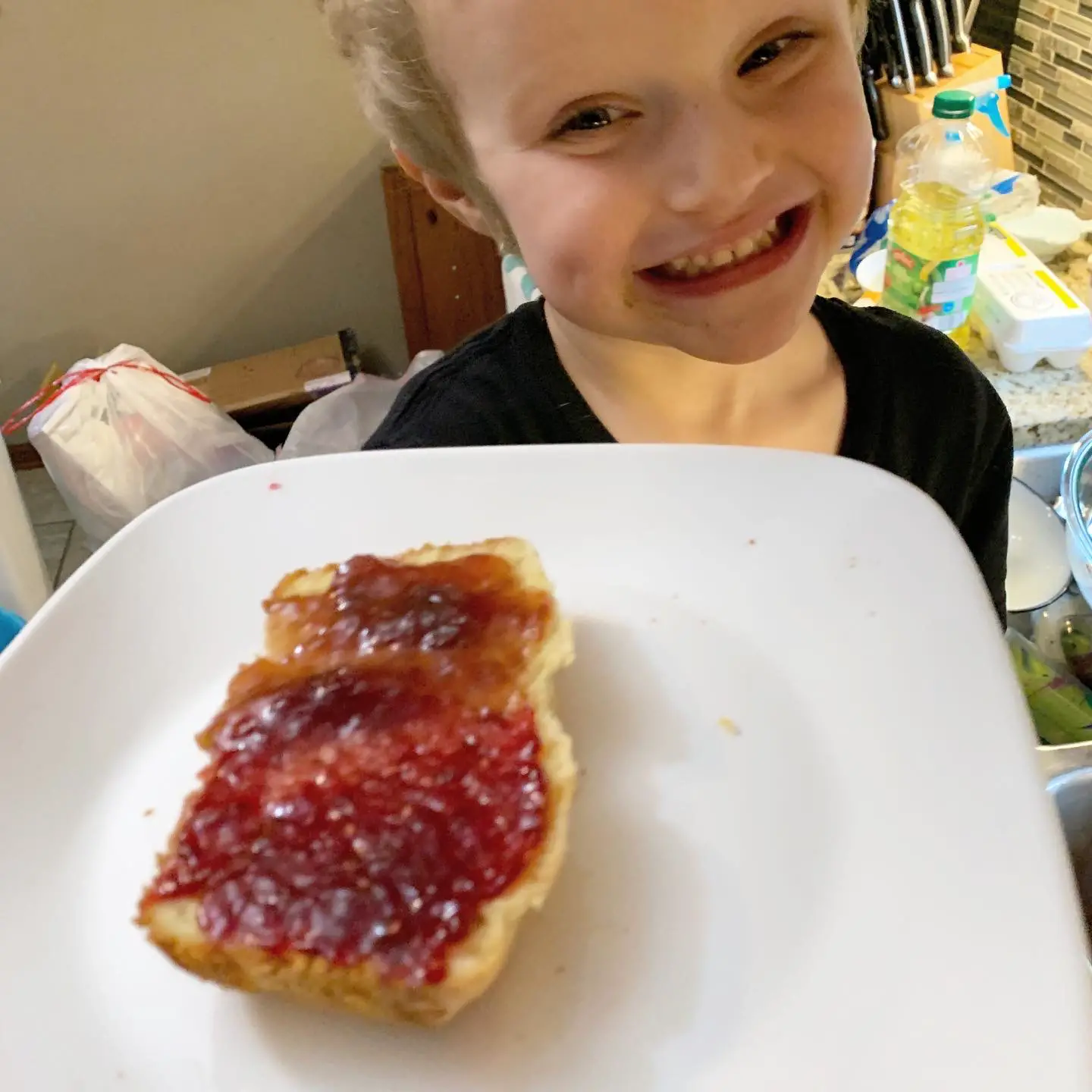The scariest part of dealing with Food Protein-Induced Enterocolitis (FPIES) is being in the early days of trying to figure out what’s going on before you have a diagnosis, or right after you get that new diagnosis, and trying to figure out where to go from there. Whether it’s you or your baby dealing with severe food allergies, the unknowns can be scary. We have been navigating the unknowns of FPIES for 8 years with my two kids, and I’m here to share the info we’ve learned along the way to hopefully help make this part of the journey a little less scary.
What is FPIES?
FPIES stands for Food Protein Induced Enterocolitis Syndrome. It’s pronounced differently by people and doctors in different parts of the world, but the most common way to pronounce FPIES is “eff-Pies”.
Food Protein Enterocolitis Syndrome is a rare food allergy that is most commonly seen in babies and young children, but there are also adults that are diagnosed with FPIES reactions to certain foods (most commonly fish or shellfish). FPIES is a non-IgE mediated food allergy that affects the GI tract. The most common FPIES reactions to a food are severe vomiting and/or diarrhea, which starts 1-4 hours after eating a food that triggers a reaction.

What does an FPIES reaction look like?
FPIES reactions can be acute or chronic, with acute reactions being more severe and lasting 24-48 hours, and chronic reactions being less intense, but taking days or weeks for symptoms to resolve.
Acute Reactions:
The most commonly diagnosed type of reaction is the acute reaction, which causes severe vomiting and diarrhea that starts suddenly and resolves within 24-48 hours. Acute reactions can be severe enough to cause sudden dehydration and hypovolemic shock in young babies, so it’s important to have a plan from a doctor that describes what to do in an emergency situation. Acute reactions can also cause reflux, and poor weight gain.
Chronic Reactions:
Chronic FPIES can cause diarrhea that lasts for days, intense stomach cramps with painful gas, lethargy, intermittent vomiting, reflux, and poor weight gain (Harizaj et al., 2017). Chronic reactions are not as commonly diagnosed, but many babies with FPIES have chronic reactions to several different foods. Chronic reactions are most often characterized by diarrhea that lasts for several days, with a foul, sour smell and a pale yellow or green watery appearance. Rashes or large red welts of raw skin often will appear on the baby’s bottom after these diarrhea episodes where the diarrhea has touched. These spots are painful but usually resolve after the diarrhea stops. Side note here, Aquaphor is amazing at helping those spots to heal. Just put it on thick with every diaper change.
FPIES reactions can look different for different babies, so the most important thing is to look for patterns to how your child reacts to their trigger foods. I’ve got a whole post here that goes more in-depth and breaks down everything you need to know about FPIES reactions and what they look like.

How is FPIES diagnosed?
Currently, there is no clinical test for FPIES. It’s diagnosed based on clinical history, meaning there has to be a pattern of several of the same type of reactions to the same food. There is a lot of new research showing that there are specific markers that show up during an FPIES reaction, so hopefully there will be a test of some sort in the future.
FPIES can be diagnosed by any doctor, but most of the time a diagnosis will come from one of three places:
- A pediatrician who knows the child well and has seen a history of the reactions, or who gets a timeline and history from the child’s parents.
- A gastroenterologist who does testing and rules out a lot of other potential issues and lands at FPIES as the last potential issue.
- An allergist who does skin prick testing and is able to rule out any IgE reactions as a cause, and who decides that FPIES makes sense based on history and types of reactions.
There’s a whole resource in my post here with more info about what kinds of help each doctor can give for severe allergies based on their specialties, and when you might need a little extra guidance from a nutritionist.
How is FPIES Treated?
There is not a cure for FPIES, but the symptoms can be managed with medication and avoidance of trigger foods. Many babies outgrow their FPIES allergies, so the biggest treatment for FPIES is just time, and waiting for the baby to outgrow their reactions to foods as their immune system and their gut mature.
Many doctors prescribe Zofran for families to keep on hand in case of severe vomiting reactions. Many FPIES babies are also put on reflux medication to help with reflux that’s often caused by FPIES. Some babies with severe reactions or IgE allergies in addition to FPIES reactions are prescribed an Epi Pen as well to keep on hand for emergencies. Our GI even prescribed a compounded cream for the raw bottom rash that our kids would get. None of these medications eliminates the source of the problem though, they just help with the symptoms once a reaction occurs.
The biggest thing you can do for a child (or adult) with FPIES is to avoid the food that’s causing the reactions. This is the only sure way to make sure they don’t have a reaction to that food. Current FPIES research suggests avoiding trigger foods for 18 months and then re-trialing that food to see if there is still an allergic response.
Many FPIES doctors use Oral Food Challenges (OFC) as a way to safely monitor patients while they re-trial foods that have caused severe reactions in the past. During an OFC, parents bring in the food that caused a reaction before, and the medical team usually does an IV on the child with FPIES to make sure they can administer IV medication to stop the vomiting and fluids quickly in case there is a reaction.
These challenges usually last several hours, and doctors will start with a very small dose of the food, then wait a certain amount of time to make sure there isn’t a reaction. If there’s no reaction, they will slowly increase the amount of the trigger food every few minutes until the child has a reaction, or until they reach a full serving of that food without any reaction at all. If they reach a full serving of the food (a “serving” varies between medical practices and depends on what the food is) with no reaction, then the OFC is a pass and they’ve outgrown their FPIES reaction to that food.
Smaller challenges are usually fine to be re-trialed at home, which is how many FPIES families do trials, just a small amount of food at a time and then wait to see what happens.

What foods cause an FPIES reaction?
There are many, many foods that can cause an FPIES reaction, but the most common ones are rice, cow’s milk, soy, oats, poultry, sweet potatoes, bananas, avocado, fish, beef, corn, peanuts, and egg (Tsou et al., 2019).
I’ve broken down the most common FPIES trigger foods in this post. If you haven’t already read it, go check it out, because there’s a lot of helpful information about how to use the foods that cause reactions to figure out which ones to try next. This is especially helpful if your child has chronic reactions to several foods and you aren’t sure what to try next.

What foods are safe for kids with FPIES?
There isn’t a magic list of foods that are always safe with FPIES, any food could potentially cause a reaction. That being said, there are some foods that are less likely to cause a reaction for most kids. Common safe foods for FPIES are: apples, pumpkin, blueberries, white potato, blackberries, quinoa, millet, almond, butternut squash, coconut, cabbage, and cassava.This list is based off of a list that our GI doctor gave us, and confirmed by experience from many other moms of kids with FPIES who have collaborated on a massive spreadsheet in our FPIES Facebook group.
Coconut is a great item to have as a safe food because it’s so versatile, you can use coconut oil, coconut flour, coconut sugar, and coconut milk to make some awesome combinations like a limited ingredient pancake or muffin.
The one thing I found from navigating FPIES with my kids is that it’s never a good idea to introduce new foods while they are getting over a reaction from something else. I found in our experience (and many other FPIES moms have told me the same was true for their kids) that if we tried to trial new foods while our kids were reacting already, they would have a much higher chance of having a reaction to the new food as well. It was always better to try new foods when we were at a “baseline” where there was no diarrhea and vomiting and things were relatively calm.
How do you find which foods are safe?
All of the info above has led us here, to the ultimate question; “how the heck do I know what to feed my baby so they don’t get sick”? People with FPIES often do food trials to figure out which foods to add or avoid. I have a whole post about it here, but a food trial is basically trying out a new food in small amounts over a period of several days or a couple of weeks, to make sure it doesn’t cause a reaction.

The reason we trial foods in small amounts is that the less of the trigger food they ingest, the less chance there is of having a severe reaction. Sometimes starting small and increasing the amount of food over several days gives the baby’s body a chance to get used to the new food.
When our kids started reacting to a new food, their body would just start trying to get rid of it, and they would throw up or have diarrhea until all of that offending food was out of their system. If you start with small amounts of food, there’s less to throw up and less chance that we would end up with a severe reaction that would land us back in the Emergency Room.

There are several different approaches to food trials at home, and I’ve outlined them in the article linked above. Some families see success from trying one food for many days in a row in small amounts without taking any breaks from that food, because their kids react to new foods after they’ve had a couple of days away from it and then the food is reintroduced.
Other families have seen more success with trialing a new food for a few days and then taking a short break and rotating in a new food. Most of FPIES is trial and error, and just finding out what works for your family. That’s why the scariest part of FPIES is those early days, when everything is unknown. Once you’ve been doing it for a while and you can figure out the patterns of your kids, it gets much easier to predict when a reaction might happen after trying new foods.
Can you Breastfeed a Baby With FPIES?
Yes, many babies with FPIES are able to breastfeed just fine, and they don’t show signs of FPIES reactions until they start solid foods. Some babies do react to foods through their mom’s breastmilk, and in those cases breastfeeding can be challenging, because mom will need to avoid the foods their baby reacts to. Sometimes, if a baby is not gaining weight due to FPIES reactions, or they are reacting to so many foods that it’s hard for them to stay healthy, doctors prescribe special baby formula that helps them get to a baseline.
Many moms decide to keep breastfeeding if their child only has a few FPIES trigger foods, but if their child has a lot of different reactions and they end up on an elimination diet, it can be harder for mom to get enough calories to make enough milk. Check out the post I’ve written here with more info on how to figure out which foods are causing reactions through breastmilk, and the one I have over here that talks about what food reactions can look like when a baby reacts through breastmilk.
Breastfeeding versus formula feeding is a conversation that needs to happen with a doctor experienced with FPIES, because there are so many variables to consider. From personal experience though, I breastfed my daughter who had many trigger foods and then she ended up on formula, because I wasn’t able to make enough milk and she was always sick.
I was so scared that formula was going to hurt her even worse than breastmilk, but it didn’t, and she did better on formula than I ever imagined. Other FPIES families I know had babies that did better with breastmilk, even with the occasional accidental reaction, than they did with formula, so it really does vary from one kid to the next.

What Kinds of Formula Work for Babies with FPIES?
Often, babies with FPIES end up needing a special kind of formula, where the food proteins are already broken down a little bit, so their body doesn’t have to work as hard to digest it. There are several kinds of formulas, from hydrolyzed formula all the way up to elemental formulas. I’ve got a whole post about the different brands and their ingredient lists and pros and cons of each type over here.
My kids were on elemental formula until they were 2 and 3 years old, and for a while, it was the only safe food either of them had. There would be times as they got older that they would get really sick or have really bad reactions and we would have to go back to just formula for a few days until they started to get back to a baseline and we could add new foods back in.
Can Kids Outgrow FPIES?
It is common for babies to outgrow FPIES sometime within their first 5 years of life. However, not all kids outgrow FPIES, and some trigger foods take longer to outgrow than others. Many people whose kids outgrow FPIES describe it like a light switch suddenly got flipped, where their child was suddenly eating everything with no issues. Other people describe it as more of a gradual change, where small amounts of trigger foods would be ok, but large amounts would still cause a reaction, and then over time the amount that could be tolerated would slowly increase.
I’ve written a post that talks about what to look for to know when your child might be outgrowing food allergies, but just like everything else with FPIES, the actual timeline can vary from kid to kid. Most kids outgrow FPIES around age 3, but kids with milk and soy allergies can outgrow them closer to ages 5 and 9 respectively. To make things more complicated, studies in different countries found different age ranges for outgrowing trigger foods. Some of this may be due to small sample sizes and the need for more research since FPIES still has so many unknowns.
We are also starting to see FPIES diagnosed at a variety of age ranges, including adults who suddenly started having violent vomiting reactions to fish or shellfish after being able to eat it their whole lives. This is now known as adult onset FPIES, and there’s more research that needs to be done before we completely understand it. However, out of the clinical studies of adults with FPIES, there hasn’t been any evidence of them “outgrowing” that allergy (Fernandes et al., 2012).

He still has trigger foods, but it gets better every year!
Is FPIES an autoimmune disease?
No, FPIES is not an autoimmune disease. Although it does share some similarities to Celiac disease, which is an autoimmune disease, there is currently no evidence showing that FPIES is autoimmune related. Many kids outgrow their FPIES reactions to foods, which also wouldn’t happen if it was an autoimmune disease. I’ve got a whole post about this here because it is a question that gets asked a lot.
If you’ve made it this far, congratulations are in order. Navigating the world of food allergies, especially rare food allergies like FPIES, is not for the faint of heart, but there is light at the end of the tunnel. It does get easier as you go, and even though there are moments that may seem utterly hopeless, research confirms that for most kids, FPIES doesn’t last forever. Be patient with yourself as you go through the learning curve, and just take it one day at a time. It gets easier, I promise.

Footnotes & Sources:
Baker, Mary Grace, MD, & Sampson, Hugh A. MD. Recent trends in food protein–induced enterocolitis syndrome (FPIES). J Allergy Clin Immunol. 2023 Jan; Volume 151, ISSUE 1, p.43-46. https://doi.org/10.1016/j.jaci.2022.11.002.
Bartnikas LM, Nowak-Wegrzyn A, Schultz F, Phipatanakul W, Bingemann TA. The evolution of food protein-induced enterocolitis syndrome: From a diagnosis that did not exist to a condition in need of answers. Ann Allergy Asthma Immunol. 2021 May;126(5):489-497. doi: 10.1016/j.anai.2021.01.001. Epub 2021 Jan 12. PMID: 33444729; PMCID: PMC8102378.
Berin MC. Immunopathophysiology of food protein-induced enterocolitis syndrome. J Allergy Clin Immunol. 2015 May;135(5):1108-13. doi: 10.1016/j.jaci.2014.12.1948. Epub 2015 Mar 5. PMID: 25746969; PMCID: PMC4426226.
Fernandes, B. N., Boyle, R. J., Gore, C., Simpson, A., & Custovic, A. (2012). Food protein–induced enterocolitis syndrome can occur in adults. Journal of Allergy and Clinical Immunology, 130(5), 1199-1200.
Harizaj, A., Schultz, F., MSW, LCSW, CAM., & Nowak-Wegrzyn, A. H., MD, PhD, FAAAAI. (2017). Clinical characteristics of chronic FPIES in infants. Journal of Allergy and Clinical Immunology, 139(2), Supplement, AB53. https://doi.org/10.1016/j.jaci.2016.12.124
Ruffner, M. A., Ruymann, K., Barni, S., Cianferoni, A., Brown-Whitehorn, T., & Spergel, J. M. (2013). Food protein-induced enterocolitis syndrome: insights from review of a large referral population. The Journal of Allergy and Clinical Immunology: In Practice, 1(4), 343-349.
Sampson, H. A., & Anderson, J. A. (2000). Summary and recommendations: classification of gastrointestinal manifestations due to immunologic reactions to foods in infants and young children. Journal of pediatric gastroenterology and nutrition, 30(1), S87-S94.
Tsou, B., Wood, R. A., Dantzer, J. A., & Keet, C., MD MS PhD. (2019). Clinical features of an FPIES cohort. Journal of Allergy and Clinical Immunology, 143(2), Supplement, AB250. https://doi.org/10.1016/j.jaci.2018.12.765
Bartnikas LM, Nowak-Wegrzyn A, Schultz F, Phipatanakul W, Bingemann TA. The evolution of food protein-induced enterocolitis syndrome: From a diagnosis that did not exist to a condition in need of answers. Ann Allergy Asthma Immunol. 2021 May;126(5):489-497. doi: 10.1016/j.anai.2021.01.001. Epub 2021 Jan 12. PMID: 33444729; PMCID: PMC8102378.

